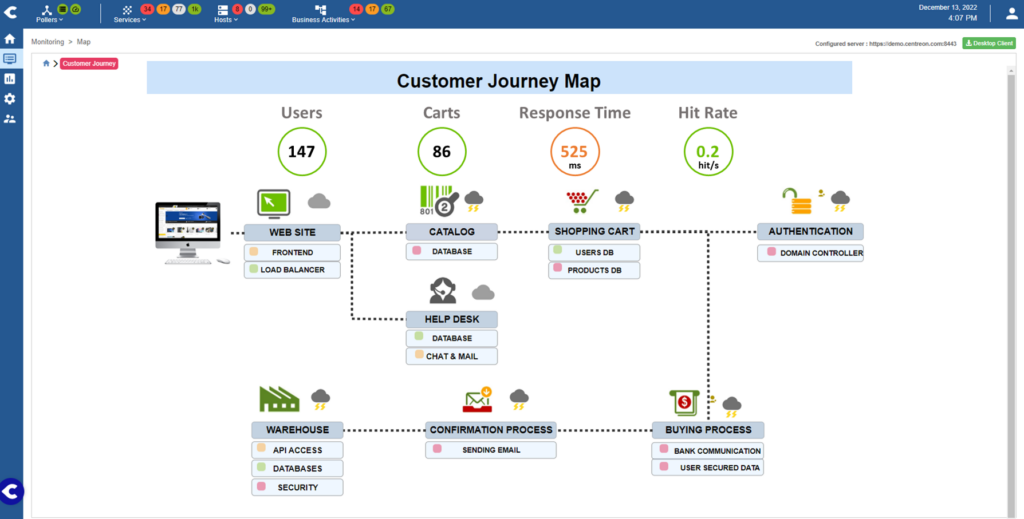User Experience Monitoring
Driving Business Performance
End user experience monitoring is one the ingredients to monitor the digital performance of your business, and is best combined with IT infrastructure monitoring.
USER CONTEXT & CHALLENGES
Reconciling IT-centric and Customer-centric performance monitoring
Digital Businesses combine Edge computing and Cloud computing to create innovative Customer Experiences where people, objects and business objectives are intertwined. Their business performance – i.e. their capacity to meet revenue targets – is very much linked to the quality of the customer experience while their productivity – their capacity to control cost – is linked to the quality of the user experience of employees.
Monitoring the IT infrastructure is a must-have since IT fuels all processes and workflows that make these customer and user experience possible. What’s even more so required is to map your business-critical IT Services to the applications, middleware or infrastructure components they rely on: you can then monitor the IT Services end-to-end performance.
Implementing IT Service performance monitoring is half the story to assess business performance. The other half requires monitoring quality of experience (QoE) of the internal or external customers.
Digital Experience Monitoring (DEM) platforms are all about monitoring the performance of this user experience. They come in all form and shapes because of the diversity of technologies that make modern IT service delivery. Some may use Synthetic Transaction Monitoring (STM) to simulate usage, others Real User Monitoring (RUM) to observe usage. Some DEM platform may reside in the application domains, others in the network domains. You may sometimes need several of them is you have a vast and diverse portfolio of business-critical IT services.
And once you have both IT-centric and customer-centric performance information what will really make an impact to align IT Operation with business objectives is to reconcile both types of information into your alerting & notification, dashboards, cockpit views and reporting monitoring platform: Centreon.
WHAT WE DO
Add User Experience Monitoring to your dashboards to take informed decisions

Centreon tightly integrates with DEM, APM and NPM monitoring platforms to collect user experience performance insights about all your critical applications and complex IT workflows. Centreon connects to monitoring platforms from Dynatrace, Pingdom, Accedian, Maltem, Sahi Pro and others. They all provide specialized tools dedicated to User Experience monitoring and implement a variety of techniques. Centreon collects from these platforms key quality of experience indicators such as the user response time or the Appdex application performance index.

Centreon maps IT Services to the applications, middleware and equipment they rely on, identifying their logical relationship and dependencies to identify causality. Modeling Service Maps for all critical IT Service allows to measure their performance, to report on SLAs and to facilitate Root Cause Analysis and decrease Mean Time To Repair. Service Maps give a higher-level view, the one that matters to organize your IT teams and activities according to business priorities.

Combining User Experience Monitoring with Service Maps gives the complete picture about Service Performance. Both User-Centric and IT-Centric indicators can now be shared into the same event console, dashboard, high-level cockpit view or report. Augmenting Service Maps with user experience monitoring indicators gives a better indication about the end-to-end performance of IT Services, leading to more accurate SLA measurements and to better informed decisions.

HOW WE DO IT
Leverage specialized tools with Centreon Indirect Monitoring connectors
Centreon can directly monitor hundreds of different types of equipment, using a variety of methods and protocols. But Centreon also implements Indirect Monitoring, a powerful method to collect relevant KPIs from adjacent specialized tools.
Centreon comes complete with a set of DEM platform connectors. Connecting to these specialized monitoring platforms using their standard APIs, Centreon regularly queries for and monitors their key user experience performance indicators. For STM platforms, this may be the user response time for each scenario, or the number of failed attempts. For RUM platforms, this may be the average connection time, or hit rate for example. Most DEM platforms come with an API and some sort of query language that Centreon uses to collect the most relevant information for each IT Service you’re monitoring.
The Centreon Auto-Discovery functionality comes handy to automatically adapt to dynamic STM implementations where new scenarios are added by application owners, either to increase the user experience monitoring coverage or to extend it to new applications. Centreon can automatically discover the new scenarios and start monitoring their KPIs.
The DEM indicators collected using this Indirect Monitoring method are no different for all other indicators Centreon collects and monitors. They may generate Alerts and Notifications, they may be included in the dashboard’s performance graphs, predictive analysis or anomaly detection may be applied to them, they may be summarized in a high-level Cockpit View shared with all business stakeholders…
Last but not least, these user experience performance indicators can be included in the Service Map that aggregates and identifies dependencies and causality for any business-critical IT Service. With Centreon, your may combine both User-Centric and IT-Centric metrics into the same Service Map to monitor one single key indicators that accurately represents the overall performance of the IT Service.
3 KEY BENEFITS
Why consider Centreon for User Experience Monitoring

Business Performance is what matters.
View how your complex IT workflows perform at delivering innovative customer experiences.

Leverage specialized tools.
Capitalize on your DEM, APM, NPMD investments to consolidate information and take informed decisions.

One single source of truth.
It takes many talents to operate IT Services, foster collaboration with customer-centric and IT-centric information in one place.
To go further
Ready to see how Centreon can transform your business?
Keep informed on our latest news


